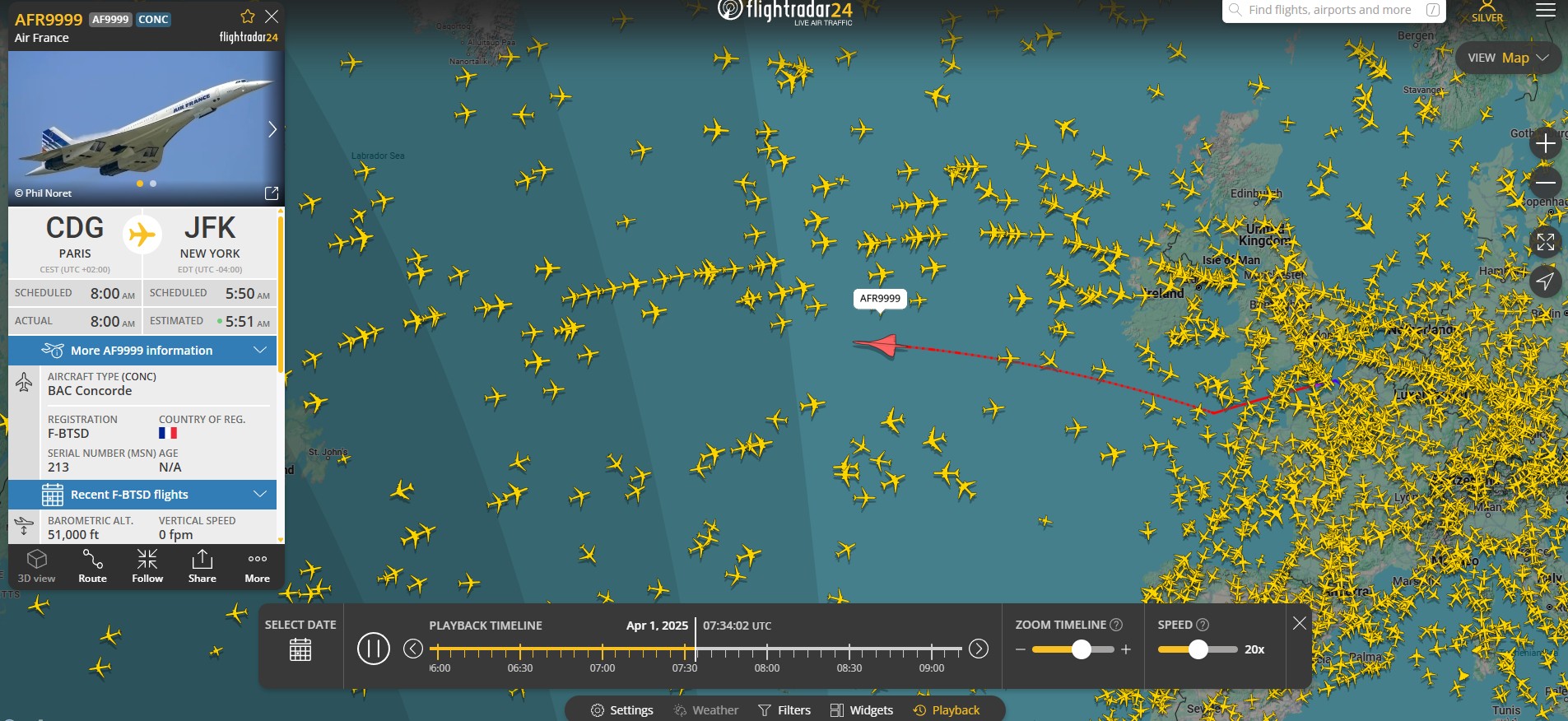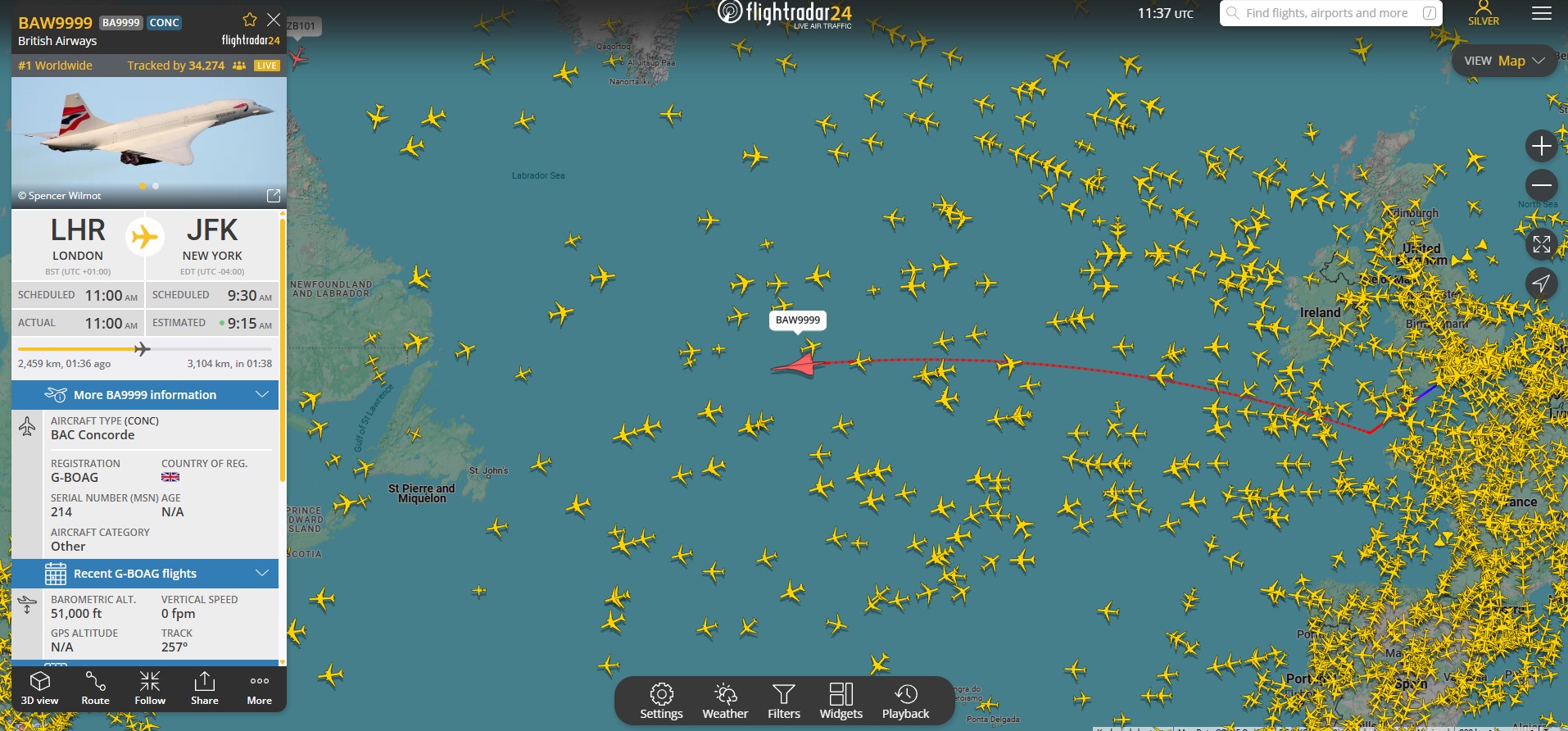


Concorde of Air France © Eduard Marmet
On Tuesday, Flightradar24 displayed the presence of extraordinary aircraft. Specifically, an Air France Concorde executed a singular flight between Paris and New York, while a British Airways Concorde also took off from Heathrow Airport.
According to flight data, flight AF9999 was conducted by the F-BTSD, an aircraft nearly 47 years old. The aircraft departed from Paris Charles de Gaulle Airport at 08:00 local time, subsequently landing at New York JFK Airport approximately four hours later. Numerous individuals responded to Flightradar24's activity. "Well done, Flightradar24! You have certainly committed to this April 1st jest," remarked an X (formerly Twitter) user. Throughout its duration, the Concorde maintained its position as the most tracked aircraft on the popular application.

At 11:00 local time, a British Airways Concorde, registered as G-BOAG, also commenced a flight from London Heathrow Airport. This aircraft operated flight BA9999 to New York JFK.
The Concorde G-BOAG, a symbol of supersonic aviation's pinnacle, holds a distinguished place in the history of flight. This aircraft, bearing the construction number 214, emerged from the British Aerospace facilities in 1978, marking the final Concorde to be assembled in the United Kingdom. Its initial registration as G-BFKW preceded its later, more recognized designation, G-BOAG, under British Airways.
Initially, G-BOAG's service was somewhat unconventional. Due to fluctuations in the Concorde fleet's operational needs, it experienced periods of both active flight and periods where it was used as a source of spare parts. This highlights the complex logistical challenges of maintaining such a technologically advanced, yet limited, fleet. However, it did return to full service, and became a very important part of the british airways concorde fleet.
A significant moment in G-BOAG's history arrived in 1985, when it became the first Concorde to showcase British Airways' new "Landor" livery. This event coincided with preparations for the airline's privatization, adding a layer of symbolic importance to the aircraft's role. It was also involved in fly pasts with the Red Arrows, which is always a spectacular sight.
G-BOAG's operational life was characterized by its regular trans-Atlantic flights, primarily between London Heathrow and New York's JFK Airport. These journeys, conducted at speeds exceeding Mach 2, significantly reduced travel times, offering an exclusive and luxurious experience to passengers. The aircraft's ability to traverse vast distances in a fraction of conventional flight times cemented its iconic status.
The retirement of the Concorde fleet in 2003 marked the end of an era. G-BOAG's final flight, a journey from New York to Seattle, was a poignant conclusion to its service. This flight, in November of 2003, brought this historic aircraft to its final resting place at the Museum of Flight, located adjacent to Seattle's Boeing Field.
Today, G-BOAG stands as a museum exhibit, allowing visitors to experience the majesty of the Concorde firsthand. It represents the height of aviation engineering, and it provides a window into a time when commercial supersonic travel was a reality. Displayed in Seattle, it continues to inspire awe and fascination, preserving the legacy of an extraordinary aircraft.

The Concorde F-BTSD served Air France and captivated the world with its speed and elegance. Constructed by Aérospatiale, its history is a testament to the technological progress of its time.
F-BTSD's operational life with Air France spanned 25 years, during which it regularly traversed the Atlantic, drastically reducing travel times between Europe and North America. Its ability to cruise at Mach 2, more than twice the speed of sound, made it an icon of efficiency and luxury. This aircraft not only transported passengers but also carried the aspirations of a generation that dreamed of faster, more connected world.
One of the more unique chapters in F-BTSD's history involves a brief period in 1996 when it sported a special Pepsi Cola livery. This promotional campaign saw the Concorde adorned in a vibrant blue color scheme, a striking departure from its usual elegant white. This event highlighted the aircraft's status as a global icon, capable of capturing the attention of millions.
Beyond its routine commercial flights, F-BTSD also achieved notable feats in aviation history. It holds world records for the fastest circumnavigations of the globe, both westbound and eastbound. These records underscore the Concorde's exceptional performance capabilities and its ability to maintain high speeds over vast distances.
Upon its retirement in 2003, F-BTSD found its final resting place at the Le Bourget Air and Space Museum in Paris. Here, it stands as a monument to a bygone era of supersonic travel, allowing visitors to marvel at its engineering and design. Notably, it is known as the last Concorde that is able to move its "droop snoot" with its own systems.
The legacy of F-BTSD extends beyond its physical presence in a museum. It serves as a reminder of the ambition and innovation that drove the Concorde program. While the era of commercial supersonic flight has passed, the memories and achievements of aircraft like F-BTSD continue to inspire and fascinate aviation enthusiasts worldwide.